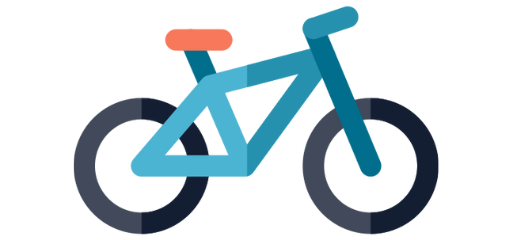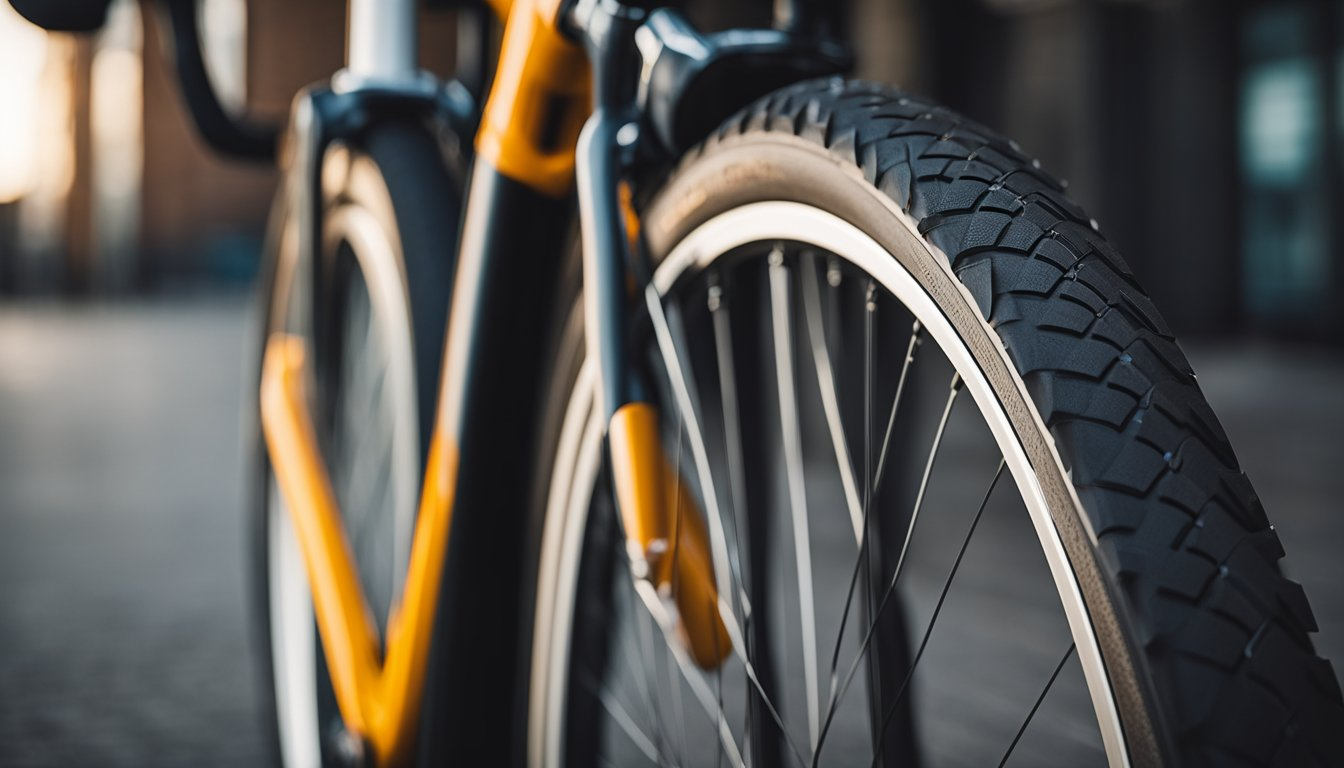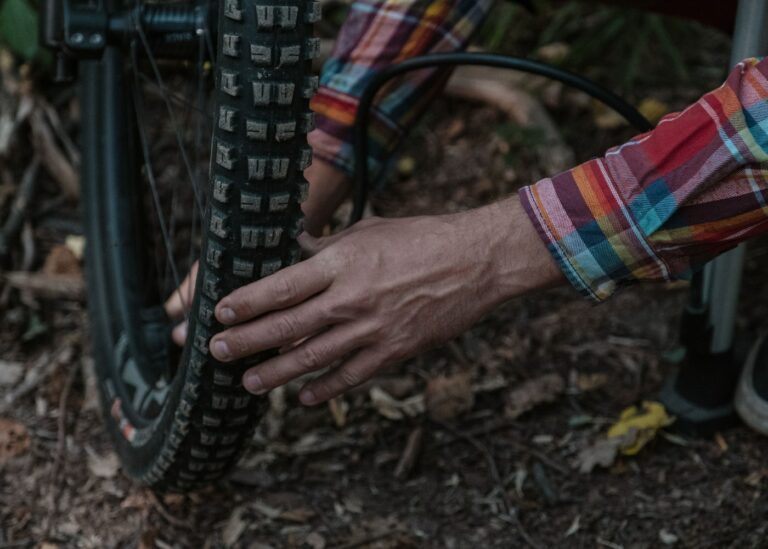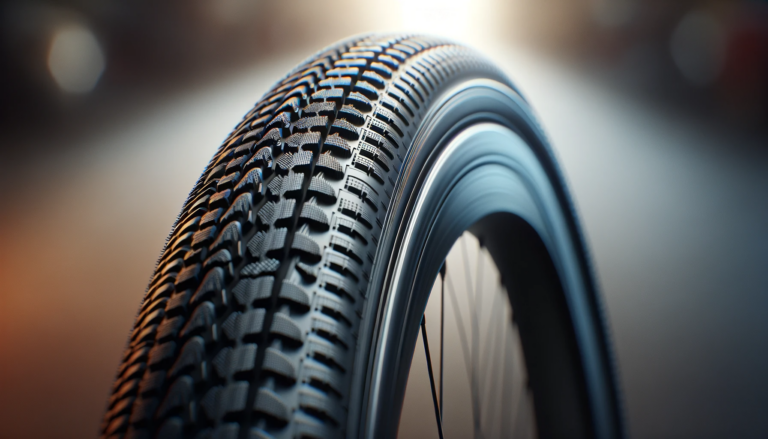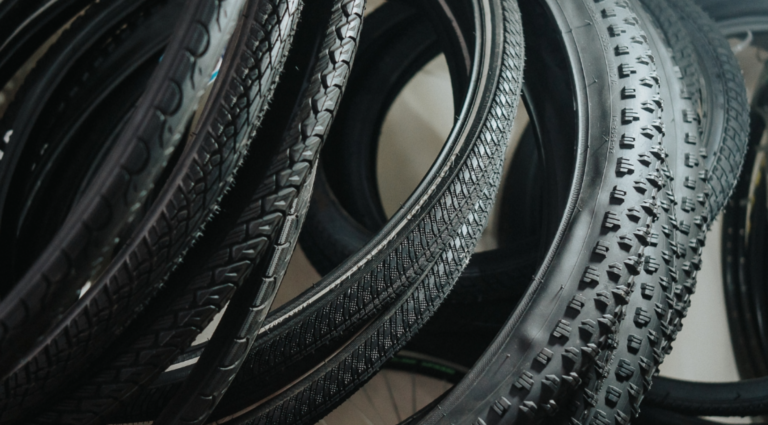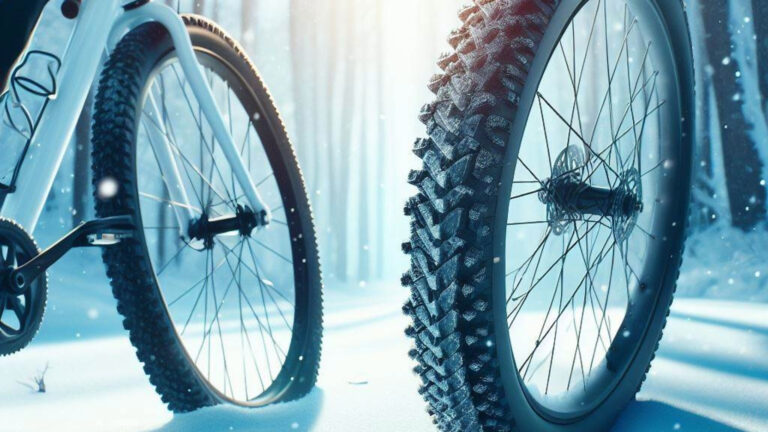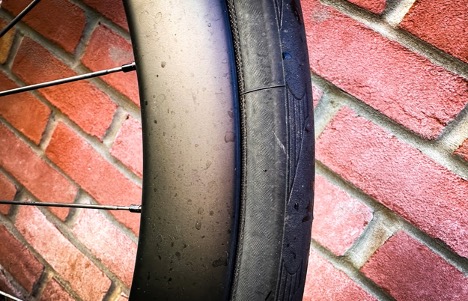Bike Tire Pressure Guide: Optimal PSI for Safety and Performance
Tire pressure plays an important role in how a bike handles, performs, and the overall comfort of the ride. Understanding how to monitor and adjust tire pressure properly can improve a rider’s overall experience and safety.
Some factors to consider when determining the right tire pressure are :
- type of bicycle
- terrain
- rider weight
- weather conditions
Each bike tire has its own recommended pressure range, which can typically be found on the sidewall of the tire. The suggested tire pressures may not always be the best for an individual rider, as personal preferences and specific riding conditions may require adjustments.
Key Takeaways
- Proper tire pressure is essential for optimal bike performance, ride comfort, and avoiding flats.
- Numerous factors influence the right tire pressure, including bike type, rider weight, and terrain.
- Regular tire pressure checks and familiarizing oneself with pressure factors are recommended for a better cycling experience.
Understanding Different Bike Types and Their Pressure Ranges
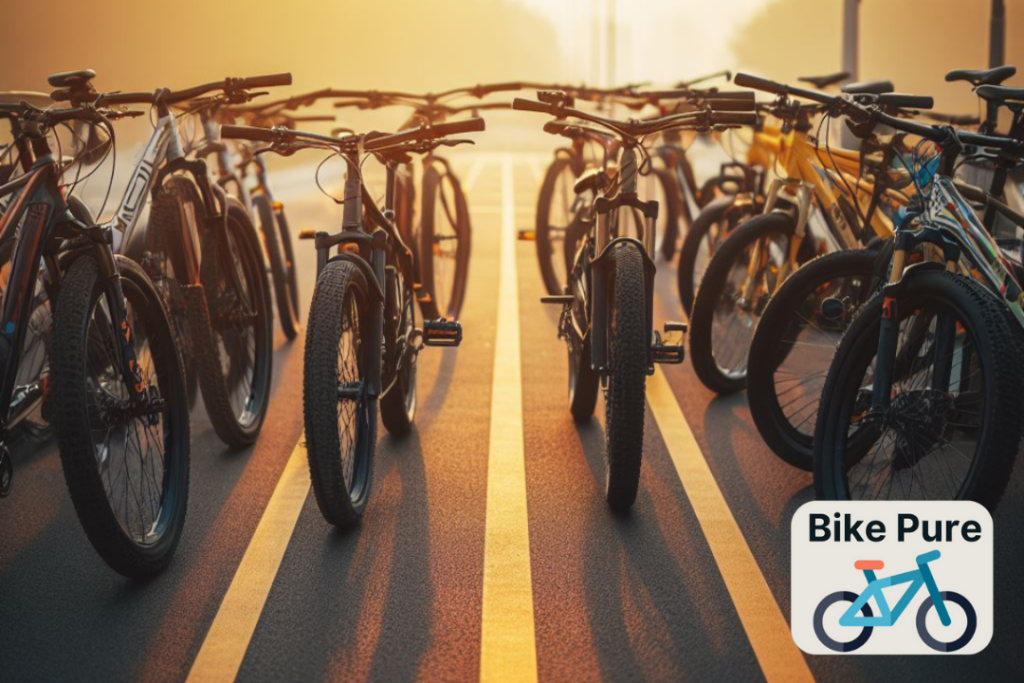
When it comes to bike tire pressure, understanding the different types of bikes and their appropriate pressure ranges is essential for a smooth and efficient ride.
This guide will cover various bike types, including Road Bikes, Mountain Bikes, Hybrid Bikes, Commuter Bikes, BMX Bikes, and Fat Bikes, along with their respective pressure ranges.
| Bike Type | Typical Tire Width | Typical Pressure Range (PSI) |
| Road Bikes | 23mm – 28mm | 80-130 |
| Mountain Bikes | 2.2-2.4 inches | 25-35 (Trail Riding) |
| Hybrid Bikes | 28mm – 42mm | 50-80 |
| Commuter Bikes | 28mm – 38mm | 60-80 |
| BMX Bikes | 2-2.5 inches | 40-70 |
| Fat Bikes | 4-5 inches | 15-30 |
Road Bikes
Road bikes are designed for speed and efficiency on paved surfaces and typically have narrow tires. A common tire width for road bikes is between 23mm and 28mm.
The typical pressure range for these tires is around 80-130 psi. Factors affecting pressure choice include rider weight, tire width, and road conditions.
A higher pressure may be more efficient, but a slightly lower pressure can provide better comfort and grip on rough surfaces.
Mountain Bikes
Mountain bikes, or MTBs, are designed for off-road riding and feature wider tires to provide better traction and stability on rough terrain. The typical pressure range varies depending on the specific mountain bike discipline, such as trail riding or downhill.
A study on the Characterization and Modelling of Various Sized Mountain Bike Tires and the Effects of Tire Tread Knobs and Inflation Pressure found that inflation pressure plays a significant role in the behavior and performance of these tires.
Trail riders generally use tires with a width of 2.2-2.4 inches, with a pressure range between 25-35 psi. Downhill riders often use wider tires (2.5 inches or more) and slightly lower pressures for enhanced grip.
Hybrid Bikes
Hybrid bikes combine elements of road and mountain bikes, offering versatility for riders on different types of terrain.
They typically feature wider tires than road bikes, ranging from 28mm to 42mm. The typical pressure range for hybrid bikes is between 50 and 80 psi, depending on rider weight and tire width. This pressure range balances comfort and efficiency for mixed-surface riding.
Commuter Bikes
Commuter bikes are designed for daily rides to work or around town on varied surfaces, and like hybrid bikes, they generally have wider tires in the range of 28mm to 38mm.
A pressure range of 60-80 psi is common, providing consistent performance for daily rides. Similarly, the pressure choice is influenced by rider weight, tire width, and road conditions.
BMX Bikes
BMX bikes are built for tricks, jumps, and racing on dirt tracks. They typically feature 20-inch wheels with wide tires around 2-2.5 inches. As these bikes are used for jumps and tricks, tire pressure is a must for stability and control.
A typical pressure range is between 40-70 psi, with higher pressures for racing and lower pressures for tricks and jumps.
Fat Bikes
Fat bikes are known for their ability to tackle sand, snow, and other challenging terrains due to their wide, low-pressure tires. Fat bike tires can be as wide as 4-5 inches and require a relatively low pressure range of 15-30 psi to provide maximum traction and stability.
Riders should consider decreasing pressure for softer terrain like sand or snow, while a higher pressure may be better for packed trails and mixed surfaces.
Bear in mind that these pressure ranges are general guidelines, and you should always consult your tire manufacturer’s recommended pressure levels and adjust based on your personal preferences, riding style, and conditions.
Factors Determining the Right Tire Pressure
Rider Weight
One important factor in determining the right tire pressure is the rider’s weight. As a general rule, increased body weight necessitates higher tire pressure to support the weight distribution and prevent pinch flats. Lighter riders can use lower pressures without compromising on performance or risking tire damage.
Tire Dimensions
Tire dimensions, including tire width and wheel diameter, play a significant role in finding the correct tire pressure. Wider tires generally allow for lower pressures, leading to a larger contact area with the surface for better grip and less rolling resistance. Conversely, narrower tires require higher pressures to maintain optimal tire volume and prevent pinch flats.
Terrain Types
The type of terrain the bike will be ridden on is another important factor in determining tire pressure. For rough or gravel surfaces, lower pressures provide better traction and smoother rides by conforming to the irregularities. On smoother roads and paved surfaces, higher pressures help reduce rolling resistance, resulting in increased speed and efficiency. It is recommended to find a balance between grip and rolling resistance based on the terrain encountered.
Weather Conditions
Weather conditions also influence the appropriate tire pressure. In wet or cold conditions, lower pressures can aid in maintaining a better grip on slippery surfaces. In warmer and dry conditions, slightly higher pressures might be more suitable for maximizing performance and tire longevity.
Tire Construction and Type
The tire construction and type (tubeless, clincher, or tubular) impact the ideal tire pressure. Tubeless systems can generally run at lower pressures, as they are less susceptible to pinch flats and can provide better traction. Clinchers (standard tire and inner tube setup) might need higher pressures to prevent pinch flats and maintain tire volume.
Furthermore, different tire materials, like supple casing or rigid construction, may also affect the ideal tire pressure based on their inherent performance characteristics.
Selecting the right tire pressure involves considering factors such as rider weight, tire dimensions, terrain types, weather conditions, and tire construction. Experimenting with different pressures within a recommended range and adjusting based on personal preferences and ride conditions will help find the optimal tire pressure for a safe, efficient, and enjoyable ride.
Essential Tools for Tire Pressure Management
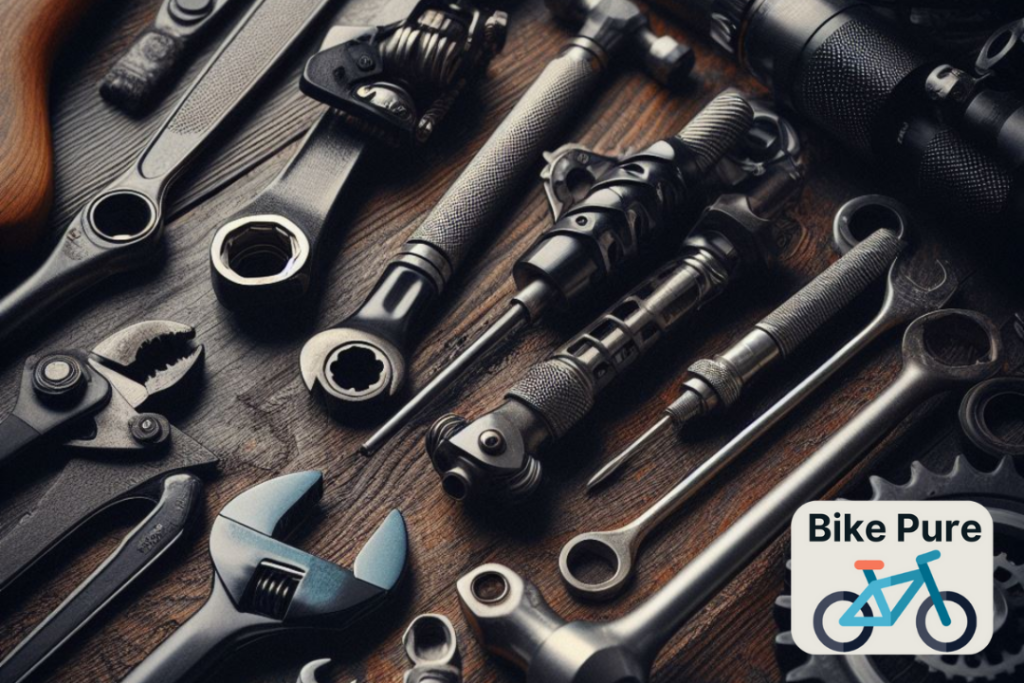
Bike Pumps
Proper tire pressure is a must for a smooth and safe bike ride, and bike pumps are an essential tool for maintaining it. There are two main types of bike pumps: floor pumps and portable pumps.
Floor pumps, which are designed for home or workshop use, typically offer a stable base, a large handle for easy pumping, and a pressure gauge for accurate readings. Portable pumps, also known as mini-pumps or frame pumps, are compact and lightweight to carry along during your bike rides for on-the-go inflation.
- Floor pumps are ideal for home use because they provide fast, efficient inflation with their high-pressure and high-volume capabilities.
- Portable pumps are convenient for cyclists to take on the road as they’re smaller and lighter than floor pumps, but they may require more pumping effort.
Pressure Gauges
A reliable pressure gauge is needed for accurate tire pressure management. Most floor pumps come with an integrated gauge, while portable pumps and standalone gauges are available for on-the-go measurements. Digital gauges, like the Topeak D2 SmartGauge, offer precise and easy-to-read measurements in PSI (pounds per square inch) units.
- Integrated gauges in floor pumps provide easy-to-read pressure measurements during inflations.
- Standalone gauges allow cyclists to check their tire pressure independently and are useful when using a pump without a built-in gauge.
Understanding Valve Types
There are three common types of valve stems used in bike tires: Presta, Schrader, and Dunlop. Each valve type has its unique features, and knowing them helps you determine the proper pump head and pressure gauge compatibility.
- Presta valves are slim and lightweight, typically found on high-performance road bikes. They have a lock nut mechanism requiring manual tightening and loosening for inflation and deflation.
- Schrader valves are wider and sturdier than Presta valves, commonly found on mountain bikes, hybrid bikes, and children’s bikes. These valves resemble automotive tire valves and are compatible with most standard air pumps.
- Dunlop valves are not as popular as the other two types but are occasionally found on some bikes, especially in European countries. They share similarities with both Presta and Schrader valves and can be inflated with a Schrader-compatible pump head.
Choose the correct bike pump and pressure gauge that correspond to your bike’s valve type. By understanding the necessary tools for tire pressure management and valve types, cyclists can maintain proper tire inflation, enhancing safety and performance on every ride.
The Implications of Incorrect Tire Pressure
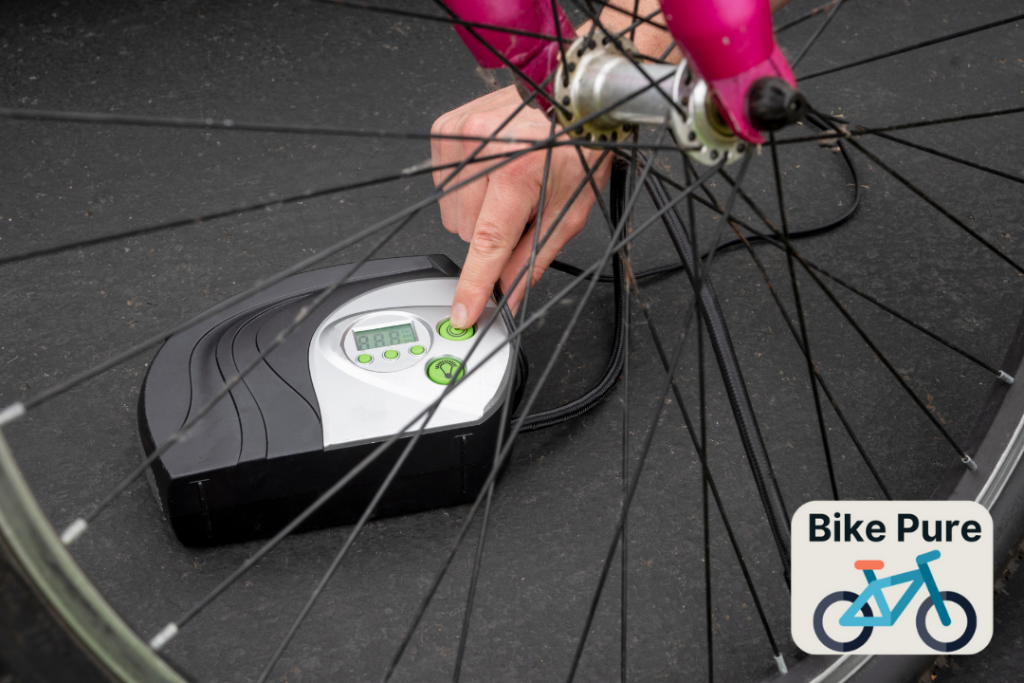
Maintaining the correct tire pressure in your bike is required for optimal performance, comfort, and safety. Incorrect tire pressure can have significant consequences, and a relevant study on the impact of uneven tire inflation pressure on vehicle dynamics provides further understanding of these safety concerns, which we will explore in the following subsections.
Over-Inflation
When a bike tire is overinflated, it exceeds the recommended maximum pressure indicated on the tire pressure chart. This can lead to a harsher ride, as the tires are less able to absorb the impact of bumps and irregularities in the road.
Over-inflation can increase the risk of a puncture, especially in tubeless tires. Follow the rule of thumb and never exceed the maximum pressure on your bike’s tire pressure chart.
Under-Inflation
Under-inflation occurs when a tire’s pressure is below the recommended minimum level. This is also detrimental to a bike’s performance, as it can lead to increased rolling resistance and reduced speed. There are a few negative aspects of having under-inflated tires:
- Comfort: Under-inflated tires can negatively affect a cyclist’s comfort, as they increase the amount of contact between the bike and the road, absorbing less shock and causing a bumpy, uncomfortable ride.
- Handling: Lower tire pressure can compromise a bike’s handling abilities, especially in corners. This is because under-inflated tires have less grip on the road, making it more challenging to maintain control during turns.
- Energy Efficiency: Reduced tire pressure increases rolling resistance, making it necessary for the cyclist to exert more effort to maintain their speed. This can lead to unnecessary fatigue or decreased overall performance.
Effects on Traction and Grip
Tire pressure also plays a significant role in determining a bike’s traction and grip on various road surfaces. When a tire is overinflated, its contact area with the road decreases, resulting in less grip during acceleration, braking, and cornering.
On the other hand, under-inflated tires can compromise road contact as well, as they tend to flatten out and lose their rounded shape. This can lead to inconsistent contact with the road and a loss of traction, particularly during cornering.
Maintaining the proper tire pressure in your bike is the foundation for ensuring a comfortable ride, safe handling, and optimal performance. Follow the recommended tire pressure chart for your bike, and always double-check your tire pressure before setting out on a ride.
Maintenance Tips and Regular Pressure Checks
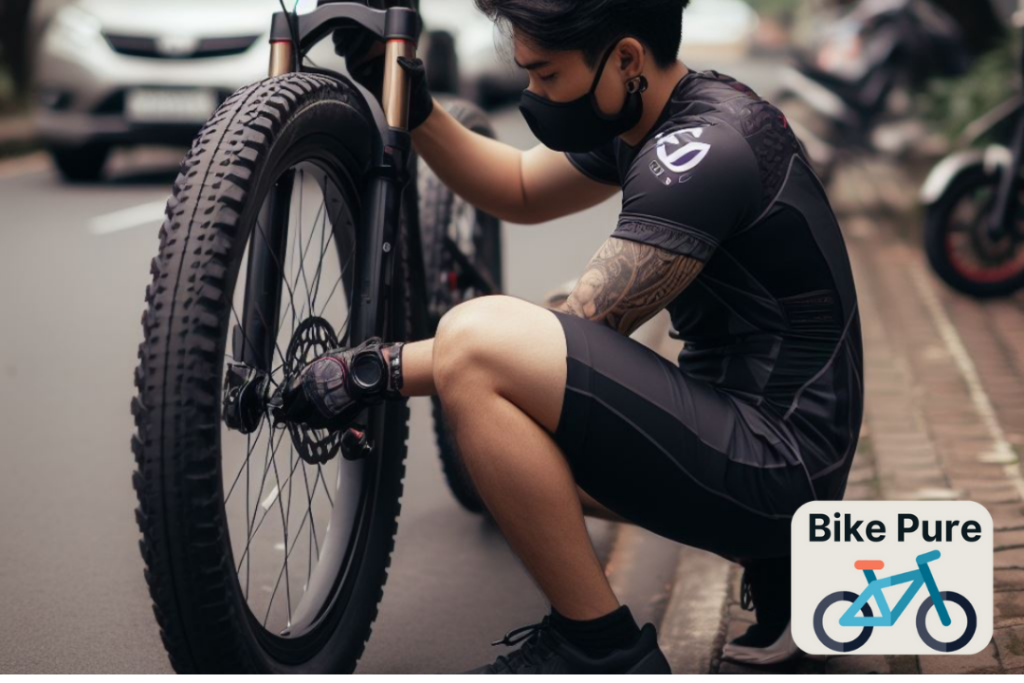
Maintaining proper bike tire pressure is necessary for a smooth, safe, and enjoyable ride. In this section, we will discuss how often you should check your tire pressure, how to recognize signs of incorrect pressure, and how altitude and storage can impact your bike tire pressure.
Frequency of Checks
Checking your tire pressure regularly ensures optimal performance and helps prevent damage to your bike’s rims and tires. For road bikes, it is recommended to check the pressure at least every other ride or once a week.
Mountain bikes, on the other hand, can have their tire pressure checked once a week. Using a reliable pressure gauge can provide accurate readings and help you maintain the correct tire pressure according to your tire pressure chart.
Recognizing Signs of Incorrect Pressure
- Too high pressure: If your bike’s tire pressure is too high, the ride will feel harsh, and the tire’s grip on the road may be compromised, increasing the risk of punctures and damage to the rim. High tire pressure may also cause your tires to wear out unevenly.
- Too low pressure: Low tire pressure can cause your bike to feel sluggish, and handling may become more challenging. Riding on underinflated tires increases the risk of pinch flats (when the tube gets pinched between the rim and the tire) and may cause damage to your rims.
To determine the optimal tire pressure for your bike, consider factors like tire width, rim compatibility, valve type, and ride style. Most tires have a recommended pressure range printed on their sidewalls, which you can use as a starting point for adjustments based on your preferences and conditions.
Altitude and Storage Impacts
Altitude and temperature changes can significantly impact your tire pressure. When you ride at higher altitudes, the decrease in air pressure can cause your tires to expand, leading to higher tire pressure.
Conversely, descending to lower altitudes will reduce tire pressure. To maintain the optimal pressure during rides with significant elevation changes, consider adjusting your tire pressure accordingly.
Storage conditions can also affect tire pressure. When your bike is stored in a hot or cold environment, the air inside the tires may expand or contract, resulting in changes in tire pressure. It’s suggested to check and adjust your tire pressure before riding, especially after your bike has been stored for an extended period or exposed to extreme temperature changes.
Special Considerations
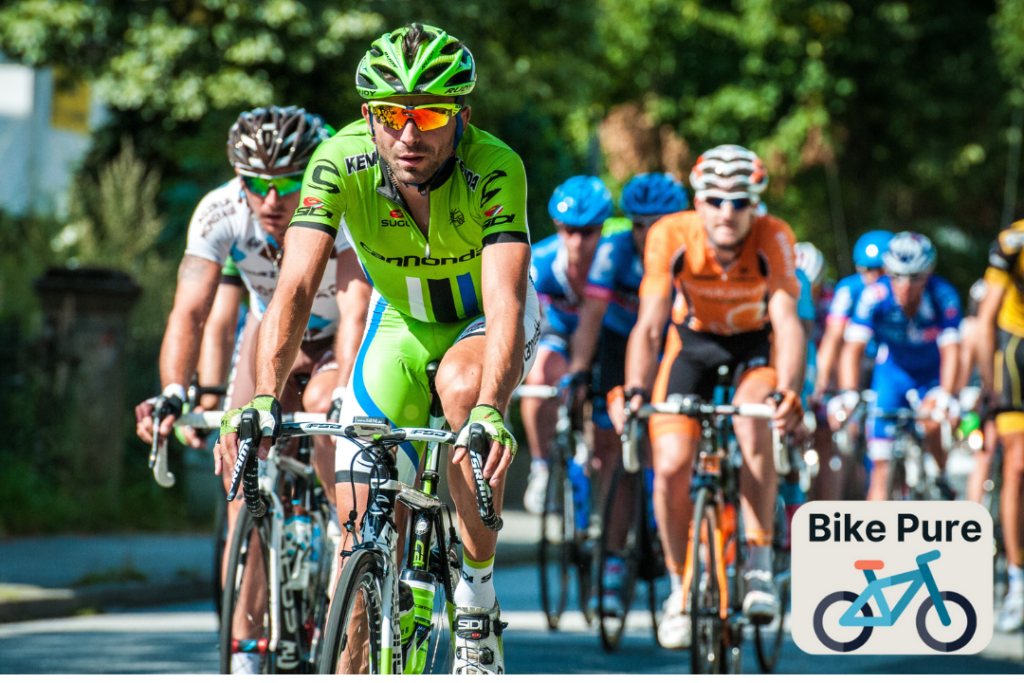
When it comes to bike tire pressure, there are several factors to consider depending on specific situations and requirements. In this section, we will discuss the special considerations for different scenarios such as racing, heavy loads and touring, and electric bikes.
Racing Scenarios
In racing scenarios, performance and speed are essential. Therefore, maintaining optimal tire pressure that ensures low rolling resistance and adequate traction is important. Generally, a higher tire pressure can lead to better rolling resistance on smooth road surfaces, increasing speed. It can compromise grip and handling.
For road racing, riders should consider factors such as their weight, the bike’s weight, the road surface, and riding style. Generally, lighter riders may benefit from slightly lower tire pressures, while heavier riders and those with tubeless tires may prefer slightly higher pressures for better traction and to prevent pinch flats.
For mountain biking and cyclocross races, lower tire pressures can provide better traction on off-road terrain and improve handling on uneven surfaces. Balancing the traction with an acceptable rolling resistance will ultimately depend on the specific course and riding style.
Heavy Loads and Touring
When carrying heavy loads or touring, the tire pressure should be adjusted to account for the additional weight. The goal is to maintain a balance between comfort, traction, and handling while minimizing the risk of pinch flats.
For a rider and bike combined weight of 170 lbs, a typical recommended tire pressure range is 90-100 psi for 23mm road tires, and it can go up to 110-120 psi for heavier riders. Slightly wider tires (25-28mm) can typically accommodate lower pressures while still maintaining the same level of performance.
When touring or carrying heavy loads, it is recommended to ensure that the tires can withstand the increased weight. Using wider tires and increasing the tire pressure accordingly can help manage the extra load on your bike more efficiently. It’s important to not exceed the maximum pressure specified by the tire manufacturer.
Electric Bikes
Electric bikes, which tend to be heavier than conventional bikes, require special considerations when it comes to tire pressure. The increased weight and added motor assistance affect handling and the tires’ overall performance.
Electric bikes benefit from higher tire pressures, as this helps reduce rolling resistance. Much like conventional bikes, it’s good to find the right balance between comfort, handling, and traction. Heavier riders or those carrying additional loads may want to experiment with the upper end of the recommended tire pressure range while maintaining a comfortable and controlled ride.
Bike tire pressure is a significant factor that affects speed, performance, and comfort in various scenarios. Different bike types and specialized riding situations such as racing, heavy loads and touring, and electric bikes need special considerations to achieve the best outcomes. Always be mindful of factors like the rider’s weight, road surfaces, and the bike’s specifications when selecting the optimal tire pressure.
Debunking Common Myths
When it comes to bike tire pressure, various misconceptions often lead to people making suboptimal choices about their pressure levels. This section will discuss two common myths: the misconception of maximum pressure and the relationship between speed and comfort.
The Misconception of Maximum Pressure
A common myth is that inflating bike tires to their maximum pressure is always the best choice for performance. While it is true that a fully inflated tire offers certain benefits like decreased rolling resistance, this does not equate to the best overall performance.
It is necessary to consider factors like tire width, the rider’s weight, and road conditions when determining optimal tire pressure. Overinflating tires can lead to a harsher ride and reduced grip, negatively affecting handling and comfort.
Here are some factors to consider when determining the ideal tire pressure:
- Tire width: Wider tires can generally handle lower tire pressures without sacrificing performance. This allows for more comfort and grip.
- Rider weight: Heavier riders may require higher tire pressure for optimal performance and to avoid pinch flats.
- Road conditions: Lower pressures can provide a smoother ride on rough surfaces, while higher pressures may be more suitable for smooth roads.
- Tire type: Tubeless tires can often handle lower pressure levels than traditional clincher tires, offering better traction and comfort.
Speed vs. Comfort
Another myth, often encountered in discussions about bike tire pressure, is the belief that higher pressure always leads to greater speed. While it is true that a harder tire can provide lower rolling resistance, which can translate into faster speeds, the relationship between tire pressure and speed is more nuanced than that.
Performance is not solely measured by speed; other factors, such as handling and comfort, play important roles in creating an enjoyable and efficient riding experience. A tire inflated to a very high pressure will provide a harsher ride, reducing comfort and negatively impacting handling.
On the other hand, a well-chosen tire pressure, tailored to the rider’s weight, tire width, and riding conditions, will strike a balance between speed, comfort, and grip. Several things must be taken into account when selecting the proper tire pressure for your bicycle, rather than simply relying on maximum pressure levels or prioritizing speed above all else. Consider experimenting with different tire pressures to find the optimal balance for your specific needs.
Remember that tire pressure is not a one-size-fits-all scenario, and understanding your individual requirements and the nuances of tire pressure will lead to a more enjoyable and efficient riding experience.
Conclusion and Best Practices
The Importance of Individual Experimentation
Experimenting with different tire pressures is suggested for every cyclist, as it allows them to find the optimal balance between comfort, efficiency, and speed. Tire recommendations vary depending on factors such as tire width, rider weight, and road conditions.
Keep in mind that the rule of thumb is to aim for a psi range between 80 and 110 for road bikes. These figures are not set in stone since individual preferences differ.
A great tool to assist you in this process is a tire pressure calculator. This device considers variables such as tire casing, rider weight, and tire width to suggest an optimal pressure that suits your needs. Remember that when using a tire pressure calculator, it is still important to experiment and make adjustments based on your personal experience.
Choosing the right tire and accessories can also contribute to better performance. For instance, opting for latex tubes or a tubeless setup may improve your experience by reducing rolling resistance and the risk of punctures. Furthermore, using high-quality high-pressure pumps ensures greater precision when inflating your tires.
Summarizing Key Takeaways and Safety Reminders
By complying with a few key recommendations, riders can enjoy a comfortable and efficient cycling experience. Here’s a brief summary of the key takeaways:
- Perform individual experimentation with tire pressures to adjust for your personal preferences
- Use a tire pressure calculator to get a good starting point
- Consider upgrading to latex tubes or a tubeless setup to improve riding efficiency
- Regularly use a high-pressure pump for greater precision in tire inflation
- Be conscious of factors such as tire width, rider weight, and road conditions when determining the ideal psi
Find the right tire pressure for your unique riding style and conditions. Focusing on factors such as tire width, rider weight, and conditions will help you choose the optimal psi for your bike.
Remember that precision and experimentation are key in finding the perfect balance for a pleasant and efficient cycling experience. So, take your time, experiment, and make adjustments as needed. Happy riding!
Frequently Asked Questions
What is the ideal tire pressure for road bikes?
The ideal tire pressure for road bikes largely depends on the rider’s weight and the tire size. As a general rule, you can start with 90 psi for narrower tires (23mm) and 80 psi for wider tires (25mm), then adjust the pressure based on personal preferences and the factors mentioned later in this article.
How do I calculate the correct pressure for my bike tires?
To calculate the correct pressure for your bike tires, first determine the tire width and your weight. Manufacturers usually provide a recommended pressure range on the side of the tire or on their websites. Use this range as a starting point and adjust the pressure accordingly based on your weight and riding conditions.
How does tire pressure affect mountain bike performance?
The performance of a mountain bike is significantly influenced by tire pressure. Higher pressure provides lower rolling resistance, allowing you to ride fast on smooth and hard surfaces.
Lower pressure increases traction and control, which is important when navigating technical terrain. Finding the optimal tire pressure for your mountain bike depends on your riding style, terrain, and personal preferences.
What factors are important to consider for optimal tire pressure?
Several factors need to be considered for optimal tire pressure, including the rider’s weight, tire size, riding conditions, and personal preferences. Heavier riders may need higher pressure to support their weight and prevent pinch flats, while lighter riders can use lower pressure for a smoother ride.
Similarly, wider tires typically require lower pressure than narrow tires. The right pressure will ultimately depend on what feels the most comfortable and efficient for your individual riding style.
Does tire pressure differ based on surface conditions?
Yes, tire pressure may need to be adjusted based on surface conditions. For example, on rough or uneven surfaces, slightly lower pressure could provide better traction and absorb vibrations.
On the other hand, higher pressure is recommended for smooth and hard surfaces to reduce rolling resistance and improve speed. It is recommended to adapt your tire pressure to the specific conditions you will encounter during your ride for the best possible performance and comfort.
